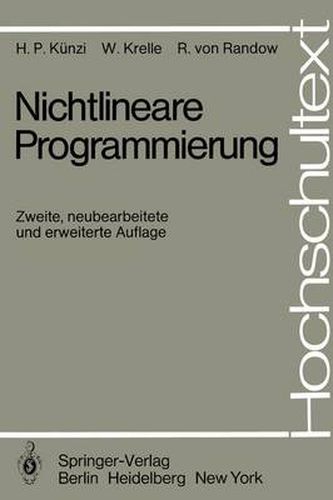Readings Newsletter
Become a Readings Member to make your shopping experience even easier.
Sign in or sign up for free!
You’re not far away from qualifying for FREE standard shipping within Australia
You’ve qualified for FREE standard shipping within Australia
The cart is loading…






This title is printed to order. This book may have been self-published. If so, we cannot guarantee the quality of the content. In the main most books will have gone through the editing process however some may not. We therefore suggest that you be aware of this before ordering this book. If in doubt check either the author or publisher’s details as we are unable to accept any returns unless they are faulty. Please contact us if you have any questions.
,, ‘—— / I, I I I \ I, I I, 0 I ——- I , \ I \ I, \, , - -, \ \ \ \ \,, I I J I, Fig. 5 gungen von (3. I) entsprechen, nlimlich: II: min {p’ x + x’ C x I A x = b, x O} (4. 6) und ill: min {p’ x + x’ C x I A x b}. (4. 7) Diese heiden Formulierungen dienen nur der mathematischen Vereinfachung. ‘Sachlich bringen auch sie nichts Neues gegeniiber I, da man die abgeanderten Ne- benbedingungen von II und ill mittels der in Kapitel II (Abschnitt 3) beschriebenen Verfahren auf die Form I bringen kann, indem man etwa eine Gleichungsrestriktion durch zwei Ungleichungsrestriktionen ersetzt oder eine unbeschrlinkte Variable als Differenz zweier nicht-negativer Variablen ansetzt. Will man umgekehrt Problem I auf die Form II bringen, so fUhrt man fUr jede Ungleichungsrestriktion aus (4. 3) eine Schlupfvariable Yj ein und ersetzt aj x b durch aj x + Yj= b, Yj 0, kurz j j Ax+y=b, y O. (4. 8) Mit (4. 9) x= 11—;–l A* = II AlE II, C* = 11– -+-g–l p* = 11—s—11 ist Problem I aquivalent dem Problem min {p*’ x* + X*‘ C* x* I A* x* = b, x* OJ, (4. 10) das die gewiinschte Form II hat.
$9.00 standard shipping within Australia
FREE standard shipping within Australia for orders over $100.00
Express & International shipping calculated at checkout
This title is printed to order. This book may have been self-published. If so, we cannot guarantee the quality of the content. In the main most books will have gone through the editing process however some may not. We therefore suggest that you be aware of this before ordering this book. If in doubt check either the author or publisher’s details as we are unable to accept any returns unless they are faulty. Please contact us if you have any questions.
,, ‘—— / I, I I I \ I, I I, 0 I ——- I , \ I \ I, \, , - -, \ \ \ \ \,, I I J I, Fig. 5 gungen von (3. I) entsprechen, nlimlich: II: min {p’ x + x’ C x I A x = b, x O} (4. 6) und ill: min {p’ x + x’ C x I A x b}. (4. 7) Diese heiden Formulierungen dienen nur der mathematischen Vereinfachung. ‘Sachlich bringen auch sie nichts Neues gegeniiber I, da man die abgeanderten Ne- benbedingungen von II und ill mittels der in Kapitel II (Abschnitt 3) beschriebenen Verfahren auf die Form I bringen kann, indem man etwa eine Gleichungsrestriktion durch zwei Ungleichungsrestriktionen ersetzt oder eine unbeschrlinkte Variable als Differenz zweier nicht-negativer Variablen ansetzt. Will man umgekehrt Problem I auf die Form II bringen, so fUhrt man fUr jede Ungleichungsrestriktion aus (4. 3) eine Schlupfvariable Yj ein und ersetzt aj x b durch aj x + Yj= b, Yj 0, kurz j j Ax+y=b, y O. (4. 8) Mit (4. 9) x= 11—;–l A* = II AlE II, C* = 11– -+-g–l p* = 11—s—11 ist Problem I aquivalent dem Problem min {p*’ x* + X*‘ C* x* I A* x* = b, x* OJ, (4. 10) das die gewiinschte Form II hat.